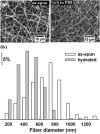A biomimetic mechanism for antibody immobilization on lipid nanofibers for cell capture
- PMID: 23213266
- PMCID: PMC3505193
- DOI: 10.1063/1.4766191
A biomimetic mechanism for antibody immobilization on lipid nanofibers for cell capture
Abstract
The immobilization of membrane-bound molecules on organic-inorganic cholesteryl-succinyl silane (CSS) nanofibers is investigated. Fluorescent microscopy and a cell capture assay confirm the stable and functional immobilization of membrane-bound antibodies and imaging agents on the electrospun CSS nanofibers. An insert-and-tighten mechanism is proposed for the observed hydration-induced reduction in lipid nanofiber diameter, the immobilization of membrane-bound molecules, and the improved efficiency of cell capture by the functionalized CSS nanofibers over their film counterparts. The ability to stably and functionally immobilize membrane-bound molecules on the CSS nanofibers presents a promising method to functionalize lipid-based nanomaterials.
Figures




References
Grants and funding
LinkOut - more resources
Full Text Sources
